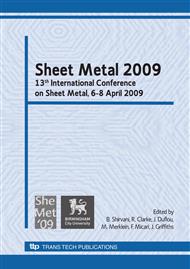[1]
Hufenbach, W.: Strukturierung und Klassifizierung von Stahlblech-Mehrschichtverbunden. Research seminar Steel Application, Düsseldorf, (1996).
Google Scholar
[2]
Sedlacek, G.; Paschen, M.; Bohmann, D.: Neuartige Fahrzeuge - Leichtbaukonzepte durch Stahlinnovation: Hydrostatisch geformte flächige Formleichtbaukomponenten und Prägeteile aus Stahlblech. Proceeding of the Dresdener Leichtbausymposium, (1997).
Google Scholar
[3]
Behrens, A.; Ellert, J.: Implementation of bionic buckling structuring for increasing stability of thin sheet-metal-structures, Proceedings of the International Conference Shemet, Belfast, (2003).
Google Scholar
[4]
Mirtsch, F.: Ressourceneffizienz und synergetische Eigenschaften durch Wölbstrukturieren; Proceedings of the 15. Sächsische Fachtagung Umformtechnik Dresden, 2008, p.155.
Google Scholar
[5]
Lange, D.; Grünbaum, M.: Actual Use of a Relief-embossed Panel in an Automotive Body; Proceedings of the International Industrial Conference Bionik 2004; Progress Report VDI; Vol. 15; No. 249; p.283 - S. 298.
Google Scholar
[6]
Sedlacek, G.: Strukturoptimierung und Erprobung von Leichtbauplatten für den Einsatz in Schienenfahrzeugen. Federal Ministry for Education and Research project: e-Sie. Car, Final report, Chair for Steel Construction, RWTH Aachen, (2004).
Google Scholar
[7]
Behr, F.; Blümel, K.; Göhler, K.; Nazikkor, C.: Aufbau und Eigenschaften des Noppenbleches, Proceedings of the DVM-day, 2000, Material and Processes und Verfahren in Competition, Lightweight Design in Vehicle Manufacturing, Berlin, pp.211-223.
Google Scholar
[8]
Innovative Bauweisen für Schienenfahrzeuge eSIE. CAR. Final report, Research Association for Steel Applications, Federal Ministry for Education and Research (Support code 19P2001), January (2005).
Google Scholar
[9]
Bohmann, D.: Ausgesteifte Plattenkonstruktion aus flächigen Formbauteilen; German patent, No. 10101612C1, 31. 10. (2002).
Google Scholar
[10]
borit Leichtbau-Technik GmbH: http: /www. borit. de, state March (2008).
Google Scholar
[11]
German Standart DIN 53293: Testing of Sandwich Elements - Bending test, Feb. (1982).
Google Scholar
[12]
Schwedish Standard SS 2562: Automobile - loading coverage - stability requirements and testing.
Google Scholar


